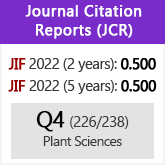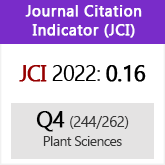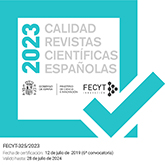The importance of phytoplankton production for carbon budgets in a semiarid floodplain wetland
DOI:
https://doi.org/10.3989/ajbm.2271Keywords:
chlorophyll-specific net primary production, plankton biomass, dissolved organic carbon, nutrients, zooplankton, macrophyte productionAbstract
Phytoplankton production (PP) in wetlands is not measured as often as that of macrophytes. A three year-study during a period of sustained high flooding was undertaken in a central Spanish floodplain wetland (Las Tablas de Daimiel National Park) to determine net PP, its spatial heterogeneity and controlling factors, and compare it with primary production in macrophyte communities. This enabled us to estimate carbon budgets for each community. All PP variables showed high spatial and temporal variability among sites, resulting in low coherence even when flooding connected all sites. Net PP corresponded to 25- 36% of submerged plant production and 3-10% of helophyte production. Net PP was controlled by different size fractions of phytoplankton biomass at different wetland sites. Neither nutrients nor zooplankton affected net PP or productivity. A high spatiotemporal variability of PP in wetlands occurs arising from complex processes that affect the underwater light field. Carbon budgets of phytoplankton often exceeded those of submerged macrophytes and attained between 4 and 37% of helophyte budgets. Although usually considered to be marginal, our study shows that PP in the open water of wetlands should be taken into account for determining accurate wetland carbon budgets, mostly in periods of high flooding, which often result in changing the carbon budget of primary producers.
Downloads
References
Álvarez-Cobelas, M. & Jacobsen, B.A. 1992. Hypertrophic phytoplankton: an overview. Freshwater Forum 2: 184-199.
Álvarez-Cobelas, M. & Rojo, C. 1994. Spatial, seasonal and long term variability of phytoplankton photosynthesis in lakes. Journal of Plankton Research 16: 1691-1716. http://dx.doi.org/10.1093/plankt/16.12.1691
Álvarez-Cobelas, M. & Cirujano, S. (eds.) 1996. Las Tablas de Daimiel: ecología acuática y sociedad. Ministerio de Medio Ambiente. Madrid.
Álvarez-Cobelas, M., Cirujano, S. & Sánchez-Carrillo, S. 2001. Hydrological and botanical man-made changes in the Spanish wetland of Las Tablas de Daimiel. Biological Conservation 97: 89-97. http://dx.doi.org/10.1016/S0006-3207(00)00102-6
Álvarez-Cobelas, M. & Cirujano, S. 2007. Multilevel responses of emergent vegetation to environmental factors in a semiarid floodplain. Aquatic Botany 87: 49-60. http://dx.doi.org/10.1016/j.aquabot.2007.03.002
Álvarez-Cobelas, M., Sánchez-Carrillo, S. & Cirujano, S. 2007. Strong site effects dictate nutrient patterns in a Mediterranean floodplain. Wetlands 27: 326-336. http://dx.doi.org/10.1672/0277-5212(2007)27[326:SSEDNP]2.0.CO;2
Álvarez-Cobelas, M., Sánchez-Carrillo, S., Cirujano, S. & Angeler, D.G. 2010. A story of the wetland water quality deterioration: salinization, pollution, eutrophication and siltation. In: Sánchez-Carrillo, S. & Angeler, D.G. (eds.), Ecology of threatened semiarid Wetlands: Long-term Research in Las Tablas de Daimiel: 109-133. Springer Verlag. Berlin.
Angeler, D.G., Álvarez-Cobelas, M., Rojo, C. & Sánchez-Carrillo, S. 2000. The significance of water inputs on plankton biomass and trophic relationships in a semiarid freshwater wetland. Journal of Plankton Research 22: 2075-2094. http://dx.doi.org/10.1093/plankt/22.11.2075
Angeler, D.G., Álvarez-Cobelas, M., Sánchez-Carrillo, S. & Rodrigo, M.A. 2002. Assessment of exotic fish impacts on water quality and zooplankton in a degraded semi-arid floodplain wetland. Aquatic Sciences 64: 76-86. http://dx.doi.org/10.1007/s00027-002-8056-y
Angeler, D.G., Álvarez-Cobelas, M., Rojo, C. & Sánchez-Carrillo, S. 2010. Phytoplankton community similarity in a semiarid floodplain under contrasting hydrological connectivity regimes. Ecological Research: in press DOI: 10.1007/s11284-009-0681-7. APHA, 1998. Standard Methods for the Examination of Water and Wastewater. 20th edition. Washington D.C.
Barber, R.T. & Hilting, A.K. 2002. History of the study of plankton productivity. In: Williams, P.J. Le B, Thomas, D.N. & Reynolds, C.S. (eds.), Phytoplankton Productivity: 16-43. Blackwell. Oxford.
Bender, M., Grande, K., Johnson, K., Marra, J., Williams, P.J. LeB, Sieburth, J., Pilson, M., Langdon, C., Hitchcock, G., Orchardo, J., Hunt, C., Donaghay, P. & Heinemann, K. 1987. A comparison of four methods for determining planktonic primary production. Limnology and Oceanography 32: 1085-1098. http://dx.doi.org/10.4319/lo.1987.32.5.1085
Brylinsky, M. 1980. Estimating the productivity of lakes and reservoirs. In: Le Cren, E.D. & Lowe-McConnell, R.H. (eds.), The Functioning of Freshwater Ecosystems: 411-454. Cambridge University Press. Cambridge.
Carignan, R., Planas, D. & Vis, C. 2000. Production and respiration in oligotrophic Shield lakes. Limnology and Oceanography 45: 189-199. http://dx.doi.org/10.4319/lo.2000.45.1.0189
Chow-Fraser, P., Lougheed, V., Thiec, V.L., Crosbie, B., Simser, L. & Lord, J. 1998. Long-term response of the biotic community to fluctuating water levels and changes in water quality in Cootes Paradise Marsh, a degradated coastal wetland of Lake Ontario. Wetlands Ecology and Management 6: 19-42. http://dx.doi.org/10.1023/A:1008491520668
Cronk, J.K. & Fennessy, M.S. 2001. Wetland Plants. Biology and Ecology. Lewis Publishers. Boca Ratón. http://dx.doi.org/10.1201/9781420032925
Cuthbert, I.D. & del Giorgio, P. 1992. Toward a standard method of measuring color in freshwater. Limnology and Oceanography 37: 1319-1326. http://dx.doi.org/10.4319/lo.1992.37.6.1319
Eloranta, P. 1999. Humus and water physics. In: Keskitalo, J. & Eloranta, P. (eds.), Limnology of Humic Waters: 59-74. Backhuys. Leiden.
ESRI, 1996. Arcview-Gis 3.0. Environmental Systems Research Institute. Redlands.
Geider, R.J. & Osborne, B.A. 1992. Algal Photosynthesis. Chapman and Hall. New York.
George, D.G., Talling, J.F. & Rigg, E. 2000. Factors influencing the temporal coherence of five lakes in the English Lake District. Freshwater Biology 43: 449-461. http://dx.doi.org/10.1046/j.1365-2427.2000.00566.x
Gessner, M.O., Schieferstein, B., Müller, U., Barkmann, S. & Lenfers, U.A. 1996. A partial budget of primary production carbon flows in the littoral zone of a hardwater lake. Aquatic Botany 55: 93-105. http://dx.doi.org/10.1016/S0304-3770(96)01064-9
Grobbelaar, J. 1985. Phytoplankton productivity in turbid waters. Journal of Plankton Research 7: 653-663. http://dx.doi.org/10.1093/plankt/7.5.653
Hairston, N.G. 1996. Zooplankton egg banks as biotic reservoirs in changing environments. Limnology and Oceanography 41: 1087-1092. http://dx.doi.org/10.4319/lo.1996.41.5.1087
Harris, G.P. 1973. Diel and annual cycles of net plankton photosynthesis in Lake Ontario. Journal of the Fisheries Research cBoard of Canada 30: 1779-1787.
Harris, G.P. 1978. Photosynthesis, productivity and growth: the physiological ecology of phytoplankton. Archiv fu.r Hydrobiologie, Ergebnisse der Limnologie 10: 1-171.
Harris, G.P. 1986. Phytoplankton Ecology. Chapman and Hall. London. http://dx.doi.org/10.1007/978-94-009-4081-9
Harris, G.P. & Lott, J.N.A. 1973. Light intensity and photosynthetic rates in phytoplankton. Journal of the Fisheries Research Board of Canada 30: 1771-1778. http://dx.doi.org/10.1139/f73-286
Harris, G.P. & Piccinin, B.B. 1977. Photosynthesis by natural phytoplankton populations. Archiv fu.r Hydrobiologie 80: 405-457.
Kirk, J.T.O. 1994. Light and Photosynthesis in Aquatic Ecosystems. 2nd edition. Cambridge University Press. Cambridge. http://dx.doi.org/10.1017/CBO9780511623370
Kufel, L. & Kufel, I. 2002. Chara beds acting as nutrient sink in shallow lakes – a review. Aquatic Botany 72: 249-260. http://dx.doi.org/10.1016/S0304-3770(01)00204-2
Leibowitz, S. & Vining, K.V. 2003. Temporal connectivity in a prairie pothole complex. Wetlands 23: 13-25. http://dx.doi.org/10.1672/0277-5212(2003)023[0013:TCIAPP]2.0.CO;2
Levine, S.N., Zehrer, R. & Burns, C.W. 2005. Impact of resuspended sediment on zooplankton feeding in Lake Waihola, New Zealand. Freshwater Biology 50: 1515-1536. http://dx.doi.org/10.1111/j.1365-2427.2005.01420.x
Liboriussen, L. & Jeppesen, E. 2003. Temporal dynamics in epipelic, pelagic and epiphytic algal production in a clear and a turbid shallow lake. Freshwater Biology 48: 418-431. http://dx.doi.org/10.1046/j.1365-2427.2003.01018.x
Lomnicki, A., Bandola, E. & Jankowska, K. 1968. Modification of the Wiegert-Evans method for estimation of net primary production. Ecology 49: 147-149. http://dx.doi.org/10.2307/1933570
López-Archilla, A.I., Mollá, S., Coleto, M.C., Guerrero, M.C. & Montes, C. 2004. Ecosystem metabolism in a Mediterranean shallow lake (Laguna de Santa Olalla, Doñana National Park, SW Spain). Wetlands 24: 848-858.
Lund, J.W.G., Kipling, C. & Le Cren, E.D. 1957. The inverted microscope method of estimating algal numbers, and the statistical basis of estimations by counting. Hydrobiologia 11: 143-170. http://dx.doi.org/10.1007/BF00007865
Manning, W.M. & Juday, C.E. 1941. The chlorophyll content and productivity of some lakes in Northeastern Wisconsin. Transactions of the Wisconsin Academy of Sciences, Arts and Letters 33: 363-393.
Marker, A.F.H., Nusch, E.A., Rai, H. & Riemann, B. 1980. The measurement of photosynthetic pigments in freshwater and standardization of methods: conclusions and recommendations. Archiv für Hydrobiologie, Ergebnisse der Limnologie 14: 91-106.
Marra, J. 2002. Approaches to the measurement of plankton production. In: Williams, P. Le B, Thomas, D.N. & Reynolds, C.S. (eds.), Phytoplankton Productivity: 78-108. Blackwell. Oxford.
McCauley, E. 1984. The estimation of the abundance and biomass of zooplankton in samples. In: Downing, J.A. & Rigler, F.H. (eds.), A Manual on the Assessment of Secondary Production in Freshwaters: 228-265. Blackwell. Oxford.
Micheletti, S., Schanz, F. & Walsby, A.E. 1998. The daily integral of photosynthesis by Planktothrix rubescens during summer stratification and autumnal mixing in Lake Zürich. New Phytologist 139: 233-246. http://dx.doi.org/10.1046/j.1469-8137.1998.00196.x
Mitsch, W.J. & Gosselink, J.G. 2001. Wetlands. Third edition. John Wiley and Sons. New York.
Olrik, K. 1994. Phytoplankton Ecology. Miljøprojekt 251. Danish Environmental Protection Agency. Copenhagen.
Ortega-Mayagoitia, E., Rojo, C. & Armengol, J. 2000. Structure and dynamics of zooplankton in a semi-arid wetland, the National Park Las Tablas de Daimiel (Spain). Wetlands 20: 629-638. http://dx.doi.org/10.1672/0277-5212(2000)020[0629:SADOZI]2.0.CO;2
Ortega-Mayagoitia, E., Rojo, C. & Rodrigo, M.A. 2002. Factors masking the trophic cascade in shallow eutrophic wetlands – evidence from a microcosm study. Archiv für Hydrobiologie 155: 43-63.
Ortega-Mayagoitia, E., Rojo, C. & Rodrigo, M.A. 2003. Controlling factors of phytoplankton taxonomic structure in wetlands: an experimental approach. Hydrobiologia 502: 177-186. http://dx.doi.org/10.1023/B:HYDR.0000004280.74279.74
Rasmussen, J.B., Godbout, L. & Schallenberg, M. 1989. The humic content of lake water and its relationship to watershed and lake morphometry. Limnology and Oceanography 34: 1336-1343. http://dx.doi.org/10.4319/lo.1989.34.7.1336
Reynolds, C.S. 2006. Ecology of Phytoplankton. Cambridge University Press. Cambridge. http://dx.doi.org/10.1017/CBO9780511542145
Reynolds, C.S., Huszar, V.L., Kruk, C., Naselli-Flores, L. & Melo, S. 2002. Towards a functional classification of the freshwater phytoplankton. Journal of Plankton Research 24: 417-428. http://dx.doi.org/10.1093/plankt/24.5.417
Robarts, R.D., Donald, D.B. & Arts, M.T. 1995. Phytoplankton primary production of three temporary Northern prairie wetlands. Canadian Journal of Fisheries and Aquatic Sciences 52: 897-902. http://dx.doi.org/10.1139/f95-090
Robinson, G.G.C., Gurney, S.E. & Goldsborough, L.G. 1997. The primary productivity of benthic and planktonic algae in a prairie wetland under controlled water-level regimes. Wetlands 17: 182-194. http://dx.doi.org/10.1007/BF03161408
Rodhe, W. 1958. Primärproduktion und Seetypen. Verhandlungen der Internationalen Vereinigung für Limnologie 13: 121- 141.
Roeder, D. 1977. Relationship between phytoplankton and periphyton communities in a central Iowa stream. Hydrobiologia 56: 145-151. http://dx.doi.org/10.1007/BF00023353
Rojo, C., Ortega-Mayagoitia, E., Rodrigo, M.A. & Álvarez-Cobelas, M. 2000. Phytoplankton structure and dynamics in the semiarid wetland National Park Las Tablas de Daimiel (Spain). Archiv für Hydrobiologie 148: 397-419.
Rott, E. 1981. Some results from phytoplankton counting intercalibrations. Schweizerische Zeitschrift für Hydrologie 43: 34-62.
Sánchez-Carrillo, S. & Álvarez-Cobelas, M. 2001. Nutrient dynamics and eutrophication patterns in a semiarid wetland: the effects of fluctuating hydrology. Water, Air and Soil Pollution 131: 97-118. http://dx.doi.org/10.1023/A:1011903300635
Sánchez-Carrillo, S. & Angeler, D.G. (eds.) 2010. Ecology of threatened semi-arid Wetlands: Long-term Research in Las Tablas de Daimiel. Springer Verlag. Berlin.
Sánchez-Carrillo, S., Álvarez-Cobelas, M., Cirujano, S., Riolobos, P., Moreno, M. & Rojo, C. 2000. Rainfall-driven changes in the biomass of a semiarid wetland. Verhandlungen der Internationalen Vereinigung fu.r Limnologie 27: 1690-1694.
Schallenberg, M. & Burns, C.W. 2004. Effects of sediment resuspension on phytoplankton production: teasing apart the influen - ces of light, nutrients and algal entrainment. Freshwater Biology 49: 143-159. http://dx.doi.org/10.1046/j.1365-2426.2003.01172.x
Talling, J.F. 1957. Photosynthetic characteristics of some fresh water plankton diatoms in relation to under water radiation. New Phytologist 56: 29-49. http://dx.doi.org/10.1111/j.1469-8137.1957.tb07447.x
Talling, J.F. 1971. The underwater light climate as a controlling factor in the production ecology of freshwater phytoplankton. Mitteilungen der Internationalen Vereinigung für Limnologie 19: 214-243.
Talling, J.F., Wood, R.B., Prosser, M.V. & Baxter, R.M. 1973. The upper limit of photosynthetic productivity by phytoplankton: evi dence from Ethiopian soda lakes. Freshwater Biology 3: 53-76. http://dx.doi.org/10.1111/j.1365-2427.1973.tb00062.x
Vymazal, J. 1995. Algae and Element Cycling in Wetlands. Lewis Publishers. Boca Ratón.
Waiser, M. & Robarts, R.D. 2004. Net heterotrophy in productive prairie wetlands with high DOC concentrations. Aquatic Microbial Ecology 34: 279-290. http://dx.doi.org/10.3354/ame034279
Walsby, A.E. 1997. Numerical integration of phytoplankton photosynthesis through time and depth in a water column. New Phytologist 136: 189-209. http://dx.doi.org/10.1046/j.1469-8137.1997.00736.x
Weisse, T. 1988. Dynamics of autotrophic picoplankton in Lake Constance. Journal of Plankton Research 10: 1179-1188. http://dx.doi.org/10.1093/plankt/10.6.1179
Westlake, D.F., Adams, M.S., Bindloss, M.E., Ganf, G.G., Gerloff, G.C., Hammer, U.T., Javornicky´, P., Koonce, J.F., Marker, A.F.H., McCracken, M.D., Moss, B., Nauwerck, A., Pyrina, I.L., Steel, J.A.P., Tilzer, M.M. & Walters, C.J. 1980. Primary production. In: Le Cren, E.D. & Lowe-McConnell, R.H. (eds.), The Functioning of Freshwater Ecosystems: 141-246. Cambridge University Press. Cambridge.
Wetzel, R.G. 1964. A comparative study of the primary productivity of higher aquatic plants, periphyton, and phytoplankton in a large, shallow lake. Internationale Revue der gesamten Hydrobiologie 49: 1-61. http://dx.doi.org/10.1002/iroh.19640490102
Wetzel, R.G. 1990. Land-water interfaces: Metabolic and limnological regulators. Verhandlungen der Internationalen Vereinigung für Limnologie 23: 1041-1048.
Wetzel, R.G. 2001. Limnology. Third edition. Academic Press. San Diego.
Williams, P. LeB, Raine, R.C.T. & Bryan, J.R. 1979. Agreement between the 14C methods of measuring phytoplankton production: reassessment of the photosynthetic quotient. Oceanologica Acta 2: 411-416.
Downloads
Published
How to Cite
Issue
Section
License
Copyright (c) 2011 Consejo Superior de Investigaciones Científicas (CSIC)

This work is licensed under a Creative Commons Attribution 4.0 International License.
© CSIC. Manuscripts published in both the printed and online versions of this Journal are the property of Consejo Superior de Investigaciones Científicas, and quoting this source is a requirement for any partial or full reproduction.All contents of this electronic edition, except where otherwise noted, are distributed under a “Creative Commons Attribution 4.0 International” (CC BY 4.0) License. You may read here the basic information and the legal text of the license. The indication of the CC BY 4.0 License must be expressly stated in this way when necessary.
Self-archiving in repositories, personal webpages or similar, of any version other than the published by the Editor, is not allowed.

















